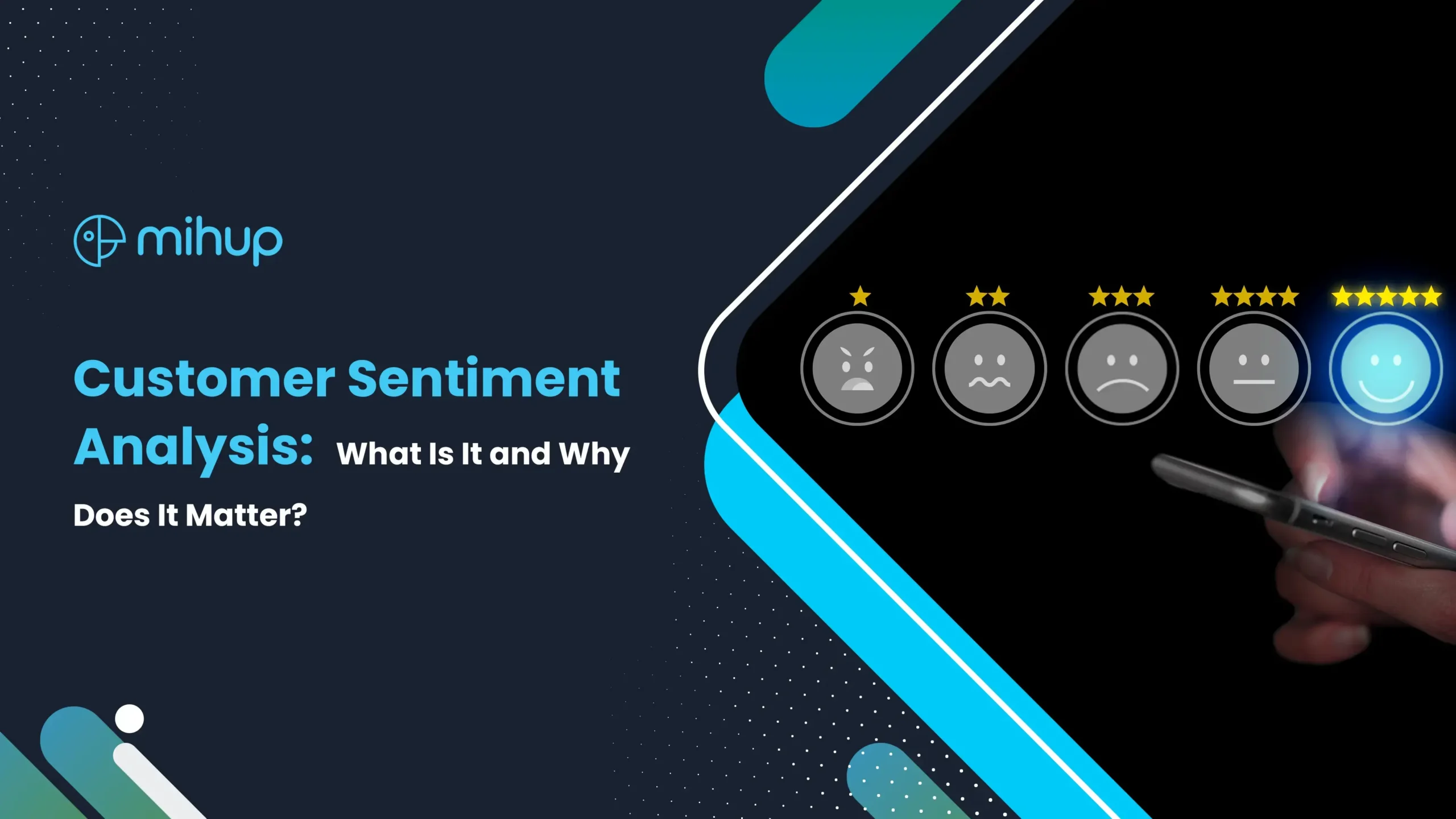In the current era, data reigns supreme, and forward-thinking, customer-centric businesses have unprecedented access to vast datasets. When harnessed effectively, this wealth of data serves as a potential instrument for not only understanding customers but also improving products and services and driving informed decision-making. Within this data-driven paradigm, customer sentiment analysis emerges as a pivotal component. By leveraging cutting-edge technology to delve into customer sentiments, businesses equip themselves with the means to take charge and pioneer in their respective domains.
Customer sentiment analysis is an indispensable element of this data revolution. This analysis classifies feedback as positive, negative, or neutral, unveiling the valuable insights that guide businesses toward continuous improvement and customer-focused strategies. Let’s delve a little deeper into Customer Sentiment Analysis.
Understanding Customer Sentiment Analysis
Customer sentiment analysis is the process of analyzing and interpreting customer feedback to gauge their feelings, opinions, and emotions towards a product, service, brand, or a specific aspect of the business.
The primary objective of customer sentiment analysis is to categorize feedback into one of three categories: positive, negative, or neutral. This classification helps in quantifying the overall sentiment of the customers. However, the process goes beyond mere categorization; it delves deeper to uncover the underlying reasons driving these sentiments.
By exploring the specifics of what triggers positive or negative feelings among customers, businesses can identify strengths to capitalize on and weaknesses to address. This deeper understanding empowers companies to refine their offerings, enhance customer experiences, and ultimately make more informed and customer-centric decisions, all contributing to long-term success in today’s competitive landscape.
How Customer Sentiment Analysis Works
Data Collection
The process begins with the collection of customer feedback from various sources. Feedback can originate from platforms such as social media, customer reviews, surveys, and customer support interactions.
Text Processing
The collected feedback data is typically in text form and requires thorough processing. Text processing includes tasks like removing noise, such as irrelevant words or symbols, which can impact analysis accuracy. Language nuances, slang, and contextual factors are considered to ensure accurate sentiment interpretation.
Sentiment Classification
Following text processing, sentiment classification algorithms are employed. These algorithms determine whether the sentiment expressed in a piece of text is positive, negative, or neutral. Sentiment classification enables the quantitative assessment of customer sentiments.
Data Analysis
Once sentiments are classified, data analysis takes place. This step involves studying the feedback data to gain insights into specific aspects that customers appreciate or find displeasing. Data analysis provides a deeper understanding of the underlying reasons behind sentiment expressions.
Feedback Integration
The insights generated through sentiment analysis are integrated into the decision-making process. Businesses utilize these insights to inform improvements in their products, services, and overall customer experiences. The data-driven decisions based on customer sentiment analysis contribute to ongoing refinement and optimization, ensuring customer satisfaction and competitive advantage.
Why Does Customer Sentiment Analysis Matter?
Understanding customer sentiment is crucial for several reasons, and it offers a multitude of benefits to businesses. Here are some of the primary reasons why customer sentiment analysis matters:
Customer-Centric Approach
In a highly competitive business landscape, companies that prioritize their customers are more likely to succeed. Customer sentiment analysis allows businesses to align their products and services with customer expectations, fostering a customer-centric approach. By listening to what customers are saying, companies can build better relationships and boost loyalty.
Read more about why customer-centric approach matters in our blog A Deep Dive into Voice of Customer and Its Solutions.
Product Improvement
Customer feedback often contains valuable insights into what’s working and what’s not. By analyzing sentiments, businesses can identify areas for improvement in their products or services. This information can lead to innovations and enhancements that cater to customer needs and preferences, ultimately increasing product quality and customer satisfaction.
Competitor Analysis
Understanding how customers feel about your competitors can provide you with a competitive edge. Customer sentiment analysis can help you identify gaps in the market or areas where your competitors might be falling short. By offering what your competitors lack, you can attract more customers to your brand.
Marketing and Branding
Customer sentiment analysis can be a goldmine for marketing and branding efforts. It helps companies understand how their target audience perceives their brand. Positive sentiments can be used as testimonials and endorsements, while negative feedback can be addressed in marketing campaigns to show that you listen to your customers and are committed to improvement.
Crisis Management
In today’s age of social media, a small customer complaint can quickly escalate into a full-blown PR crisis. Customer sentiment analysis enables companies to identify and address issues before they spiral out of control. By responding to negative sentiments promptly, companies can prevent potential damage to their reputation.
Predicting Trends
Analyzing customer sentiment can help companies anticipate emerging trends and market shifts. By identifying what customers are discussing and how they feel about certain topics, businesses can stay ahead of the curve and adjust their strategies accordingly.
The Role of Artificial Intelligence in Customer Sentiment Analysis
Customer sentiment analysis has witnessed remarkable improvements, thanks to the integration of Speech Analytics empowered by Artificial Intelligence and Machine Learning. These advanced technologies have revolutionized the way businesses understand and leverage customer feedback. Here’s how AI-driven Speech Analytics enhances Customer Sentiment Analysis:
Enhanced Accuracy and Speed
AI-powered Speech Analytics systems can process vast quantities of audio data quickly and with higher accuracy compared to human analysts.
This efficiency allows businesses to keep real-time tabs on customer sentiments, promptly identifying shifts in emotions and enabling them to make data-driven, timely decisions to address concerns or capitalize on positive trends.
Multilingual Capability
AI-driven Speech Analytics excels in multilingual analysis, making it exceptionally valuable for global businesses.
It can analyze customer interactions in various languages, facilitating a deeper understanding of diverse customer sentiments, regardless of the region or language of communication.
Social Media Monitoring
In addition to transcribed speech data, AI-powered Speech Analytics systems can also monitor social media platforms, providing a comprehensive view of how customers are reacting to a brand, product, or service.
By continuously tracking social media conversations 24/7, businesses can promptly respond to emerging issues or seize opportunities presented by positive trends.
Sentiment Scoring
AI algorithms employed in Speech Analytics assign sentiment scores to individual customer interactions, enabling a more granular analysis.
This granular approach helps distinguish between nuanced sentiments, such as mild dissatisfaction and extreme frustration, providing businesses with deeper insights into customer emotions and preferences.
Incorporating Speech Analytics into Customer Sentiment Analysis allows businesses to tap into a broader spectrum of customer feedback, encompassing both spoken and written communication. This comprehensive approach offers unparalleled insights into customer sentiment, enabling companies to refine their products, services, and customer experiences with precision. By harnessing the power of AI-driven Speech Analytics, businesses can ensure that they are always in sync with customer sentiments and well-equipped to adapt, innovate, and thrive in an ever-evolving marketplace.
Read more about Sentiment Analysis through AI in our blog Sentiment Analysis in NLP.
Customer Sentiment Analysis for Industries
Customer sentiment analysis finds applications in a wide range of industries. Here are a few examples of how businesses put sentiment analysis to use:
- E-Commerce: E-commerce platforms use sentiment analysis to evaluate product reviews. Positive reviews can be highlighted, while negative ones can prompt improvements or identify problematic products.
- Hospitality: Hotels and restaurants use sentiment analysis to assess customer reviews and ratings on platforms like TripAdvisor or Yelp. They can identify areas for improvement in service quality and overall customer experience.
- Healthcare: Patient feedback is essential for healthcare providers. Sentiment analysis of patient reviews can help hospitals and clinics improve their services and patient care.
- Airlines: Airlines analyze passenger feedback to enhance the travel experience. This includes assessing comments on in-flight services, customer service, and overall satisfaction.
- Finance: Banks and financial institutions use sentiment analysis to monitor customer feedback, identify potential issues, and improve customer service in an industry that relies heavily on trust.
Challenges and Limitations
While customer sentiment analysis offers numerous benefits, it’s not without its challenges and limitations. Some of the key challenges include:
- Contextual Understanding: Understanding the context of a statement is crucial. Words alone might not convey the true sentiment. For example, the phrase “cool as a cucumber” may appear negative if taken out of context.
- Sarcasm and Irony: Detecting sarcasm and irony can be challenging for sentiment analysis tools, as these forms of communication often involve saying one thing and meaning the opposite.
- Data Noise: Noisy data, including misspellings, slang, or unstructured text, can lead to inaccurate sentiment analysis. Pre-processing and data cleansing are essential but not always foolproof.
- Cultural Nuances: Customer sentiment can be influenced by cultural factors, and understanding these nuances can be challenging, especially in a global context.
- Limited Accuracy: While AI has improved the accuracy of sentiment analysis, it is not always 100% accurate. Human intervention and validation are often required to ensure the results are meaningful.
Customer sentiment analysis provides businesses with crucial insights into customer perceptions of their products and services. This understanding drives improved customer experiences and competitiveness.
As technology advances, sentiment analysis tools will become more accurate and essential in business strategies. In a customer-centric world, investing in sentiment analysis is vital for meeting evolving expectations and thriving.
Whether you’re a startup or an established business, adopting sentiment analysis is a strategic move. Your customers are speaking; it’s time to listen. For those interested in AI-powered sentiment analysis, explore the latest solutions for data-driven insights. Understanding customer sentiments is not an option but a necessity for success in today’s business landscape.





